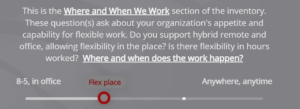30 Mar 7 Steps to Building Strategy Programs the Right Way
For over 20 years, Revenue Rocket has worked with IT services and tech-enabled services leaders to grow their businesses through organic and acquisition-driven ways. In working with hundreds of IT-managed service providers, application integrators, application developers, and cybersecurity firms, defining and implementing strategy is key to success.
Chelsey Nord, Revenue Rocket’s Strategy practice lead, breaks down seven critical items to a firm’s ability to craft and own strategy.
Make a Choice
Strategy is a set of choices. You must choose where you intend to win, and it can’t be at everything!
Not making a decision is still a choice! As Jim Collins said, “Focusing solely on what you can potentially do better than any other organization is the only path to greatness.” The most successful strategic leaders are effective decision-makers. They make strategic decisions with conviction and are resolute in following through with their choices. Everyone on the team understands the choice, whether they personally agree.
The Reveneue Rocket growth strategy model guides leaders to drive focus and intention through specializing in a set of product and service offerings, as well as positioning to a target market whose pain points and needs are addressed. If you want to be #1 or #2 in the market, you must go all in on a specialty and do it better than anyone else.
Why is making a decision difficult?
Making choices about what to eat for breakfast is generally easy. Making strategic choices about an organization’s future is not always easy.
Choosing takes courage! Leaders must have confidence in their decisions and understand the impact of alternatives. Saying ‘yes’ to each strategy/initiative means you are saying ‘no’ to another use of resources…this is especially difficult when the market is disrupted, or there is a burning platform, rowdy market, and seriously impactful macro contextual trends.
Choosing is difficult for more task-focused individuals-quantity over quality, those who think the more work that’s done, the better.
For others, choosing may require challenging the status quo, and the change management required seems daunting and unmanageable.
Make a Smart Choice
Making a choice isn’t enough for a winning strategy. Part two is about making informed decisions about where to win. This is where the Revenue Rocket Specialize, Verticalize, Productize (SVP) growth strategy method comes into play. You must pick markets where problems are clearly defined, and you have the ability to solve them uniquely.
To make an informed choice, you need to know your firm’s capabilities, strengths, and unique value proposition – what you do better than most! Next, you must engage the experts who understand the market and how those strengths should be positioned to drive meaningful growth and box out competition. Strategy is an art and science that requires taking calculated risks.
To make that informed choice, work with a firm to define the competitive landscape, build an understanding of market size and opportunity, and test offerings that resonate with potential buyers.
Bridge strategy with solid execution
A brilliant strategy will only yield growth and business results if executed effectively. A strategy must be more than decisions and words on paper of a brilliant plan. Teams must be diligent to ensure the most important work is resourced appropriately. As acknowledged in The 4 Disciplines of Execution, you must focus primarily on achieving your wildly important goal (WIG) or nothing else you do matters much. It’s very easy in rowdy markets or a VUCA environment to get distracted by the whirlwind of fire drills, but there is great danger in losing sight of your most important goal.
Questions to ask yourself:
- Does the work teams perform daily, and does how resources are deployed align with your strategy and most critical goal(s)?
- Is there a prioritization process to ensure time and resources are aligned appropriately?
- Do functions/departments have skin in the game, or are they focused on their goals?
Know you may get it wrong, so stay nimble!
One quote on being aware and open in regard to a strategy that resonates here is from A.G. Lafley, who said, “Let’s execute along this strategy, but know that we’ll probably get some of this wrong, so be open to changing it.“
It’s important to be introspective and agile with the execution of strategy. While you don’t want to change strategy multiple times a year, leaders must be open to changing how to reach the result if the current plan isn’t getting the business closer to achieving goals.
Agile working disciplines and organization design can help tremendously to stay nimble with execution when done correctly! Ideally, agile teams establish a goal for each iteration that drives the highest value to the business. Ideally, teams are all accountable for delivering on the goal.
While not revolutionary or exhaustive, Agile working principles include:
- Having management rigors and disciplines in place to regularly review results and pivot. Options include Traction EOS or Scaling Up
- Working tools to translate strategy to tactics via tasks will keep alignment and drive meaningful action
- Showing burndown charts and aligned leading indicators to strategic targets
- Driving engagement and accountability with iteration planning, retros, and standups, and empowering teams to drive results
Align Strategy with Culture
An organization can have incredible capabilities in an underserved market with a compelling need and be unsuccessful if the culture doesn’t align or drive that strategy. The [often overlooked and sometimes messy] fact is that people make the business strategy come to life.
What’s more, people are often unpredictable and inconsistent. To drive strategy, you need alignment between how things are done in your business (values, norms, behaviors) and business strategy to win. You need the right talent who understands and buys into the strategy and knows how they contribute.
By Culture, we refer to the shared beliefs, norms, values, and ways of working (not employee satisfaction or engagement). Revenue Rocket has a unique Organizational Culture Inventory comprised of 9 cultural components to help define ‘How you do things around here.’ This model helps you define norms so you can grow your team, foster a strong culture, understand areas of misalignment, and support your most valuable assets. A few examples :
Risk Tolerance
Where & When We Work
Accountability Through a Shared Scoreboard
You can’t win if you don’t keep score! In order to ensure alignment with how the team is performing, you must have a measurement strategy and a scoreboard of KPIs that align with your goals. It’s best to start simple with no more than 5-15 metrics in your scoreboard. It will be an iterative learning process as you start to understand which metrics matter most.
Through Revenue Rocket growth strategy advising, we recommend BOTH a set of top-of-house growth and profitability targets (rearview mirror) telling you where the business is AND leading indicator KPIs (dashboard) that tell you what’s coming. Data and insights from a shared scorecard provide visibility to your team in performance, the opportunity to celebrate wins, determine where to double down or pivot, and a foundation for team accountability to shared results.
The Right Involvement & Expertise
You don’t know what you don’t know. There is value in diversity of thought and exposure in the strategy development process. Many firms rely on internal resources for strategy without bringing in external perspective on the market, industry, customer, or macro-environmental trends that can greatly impact the success of a strategic plan.
Consider bringing in expert advisors who can help educate as thought leaders and share insights, especially in contexts of rapid change.
Make Sure Your Strategy is a Strategy!
Many times organizations believe they have a strategy, but they aren’t strategies at all. Rather, it’s common to have a mix of tactics and initiatives that don’t form a cohesive outcome-oriented and directional plan. Successful winning strategies must be formed from a cohesive set of choices that provide direction and aligned outcomes. Strategies, driven by tactics, aligned to growth outcomes.




